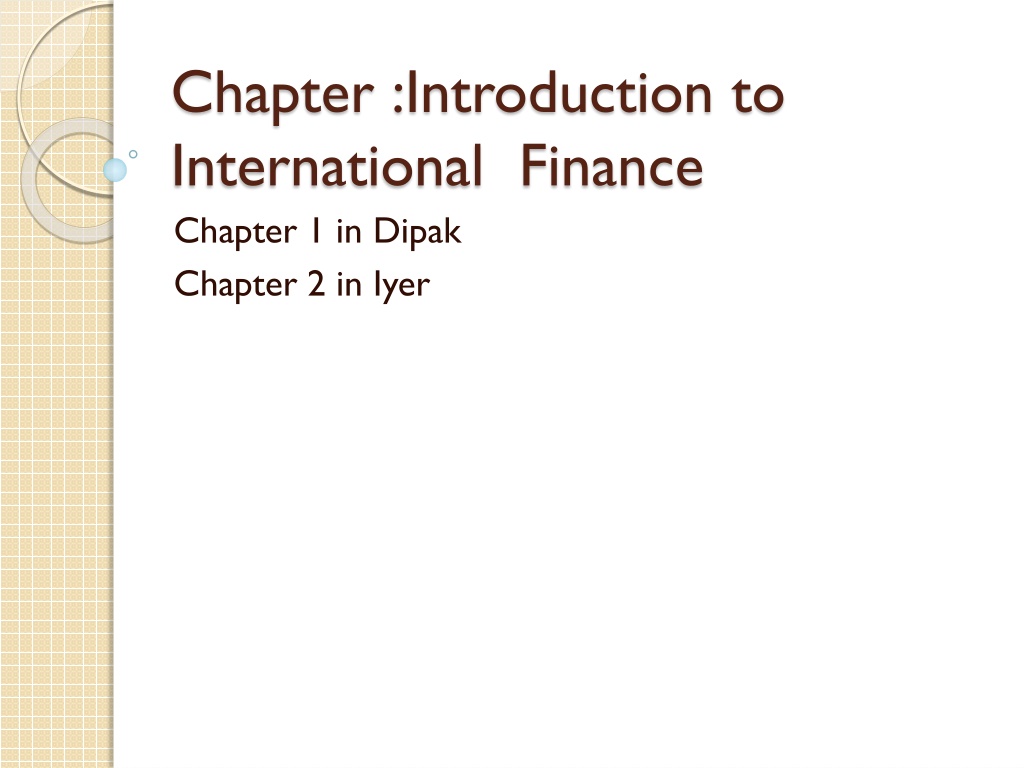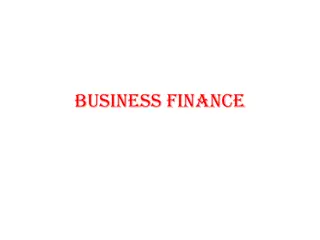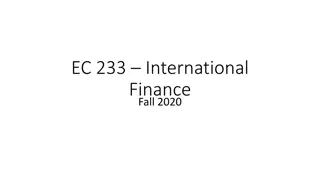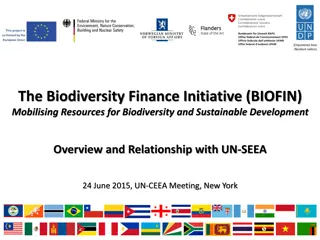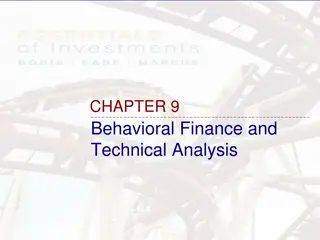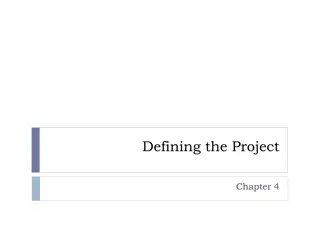Understanding International Finance: Scope, Importance, and Challenges
International finance explores interactions between countries, including currency exchange rates, foreign direct investment, and risk management. The scope includes foreign exchange markets, MNC financial systems, and international accounting. It raises questions on liberalizing financial markets, IMF reforms, and global economic growth. Components involve foreign currency markets, foreign exchange markets, and capital markets. Features include expanded business opportunities, forex risks, and political risks. Understanding international finance helps in analyzing inflation rates, interest rates, and financial risks, while the balance of payments records all economic transactions between a country and the rest of the world.
Download Presentation

Please find below an Image/Link to download the presentation.
The content on the website is provided AS IS for your information and personal use only. It may not be sold, licensed, or shared on other websites without obtaining consent from the author. Download presentation by click this link. If you encounter any issues during the download, it is possible that the publisher has removed the file from their server.
E N D
Presentation Transcript
Chapter :Introduction to International Finance Chapter 1 in Dipak Chapter 2 in Iyer
Meaning: International Finance is an area of financial economics that deals interactions between two or more countries Concerning itself with topics such as currency exchange rates, international systems, FDI, and issues of international financial management Including political risk and foreign exchange risk inherent in managing corporations. with monetary monetary multinational
Scope of IF With increasing volumes and complexities of international business, the study of international finance has become a specialized subject dealing with study of- Foreign exchange markets Exchange rates MNC financial systems Risk management International accounting systems
Should emerging market economies liberalize their financial markets What has happened (what will happen) to the dollar How, if at all, should we reform the IMF Q s usually addressed under IF Is this good for world economic growth, or a source of instability Is the current account deficit too large? Should China devalue its Yuan
Components of IF Components Foreign currency Mkts (lending & borrowing) Foreign exchange Mkts ( paying for EX-IM) Capital mkts ( Bonds, debentures, ADR, GDR etc)
Features of IF Expanded opportunities to business Forex Risk Imperfect markets Political risk
Importance of IF International finance helps in understanding inflation rates, interest rates, financial risks etc
BOP The balance of payments (BOP) of a country is the record of all economic transactions between the residents of a country and the rest of the world in a particular period It is a method countries use to monitor all international monetary transactions at a specific period of time These transactions can be made by individuals, firms and government bodies.
Current Account Capital Account Export and Import of Goods (Merchandise Transactions or Visible Trade) also called BOT Balance of Trade Export and Import of Services (Invisible Trade) travel,transportation, insurance, other misc services, transfer of interest, dividends profits, remittance (gifts) Loans (borrowing & Lending) Investments (issue of equity,bonds, term loans, acquisition of assets) Non monetary Gold Private, Banking, Government
Third Component of BOP: Reserve A/c Stock of foreign currency denominated assets held by monetary authority of the country Includes Forex reserves of RBI Monetary Gold Contribution to IMF SDR by IMF
SDR The SDR is an international reserve asset, created by the IMF in 1969 to supplement its m The SDR is neither a currency nor a claim on the IMF. Rather, it is a potential claim on the freely usable currencies of IMF members. SDRs can be exchanged for these currencies member countries official reserves
SDR The SDR basket is reviewed every five years, or earlier if warranted, to ensure that the SDR reflects the relative importance of currencies in the world s trading and financial systems. During the last review concluded in November 2015, the Board decided that the Chinese renminbi (RMB) met the criteria for inclusion in the SDR basket
Criteria for inclusion in the SDR basket Export criterion: Issuer of currency is an IMF member or a monetary union, that includes IMF members, who is one of the top five exporters of the world. Determined to be freely usable currency by the IMF Currency is widely used to make payments for international transactions and widely traded in the principal exchange markets
SDR Fixed Number of Units of Currency for a 5-year period Starting Oct 1, 2016 Weights determined in the 2015 Review Currency U.S. Dollar 41.73 0.58252 Euro 30.93 0.38671 Chinese Yuan 8.33 1.0174 Japanese Yen 8.09 11.900 Pound Sterling 10.92 0.085946
Quantitative easing (QE) 'Quantitative Easing' is an unconventional monetary policy in which a central bank purchases government securities or other securities from the market in order to lower interest rates and increase the money supply Central banks are responsible for keeping inflation in check
Before the financial crisis Before the financial crisis of 2008-09 Central bank managed that (inflation) by adjusting the interest rate at which banks borrow overnight If firms were growing nervous about the future and scaling back on investment, the central bank would reduce the overnight rate That would reduce banks' funding costs and encourage them to make more loans,keeping the economy from falling into recession.
During Crisis When the crisis struck, big central banks like the Fed and the Bank of England slashed their overnight interest-rates to boost the economy. But even cutting the rate as far as it could go, to almost zero, failed to spark recovery. CB started using new tool for managing inflation called QE
How QE works To carry out QE central banks create money by buying securities, such as government bonds, from banks, with electronic cash that did not exist before. The new money swells the size of bank reserves in the economy by the quantity of assets purchased hence "quantitative" easing. QE encouraging banks to make more loans. is supposed to stimulate the economy by Due government bonds to mortgages to corporate debt are lower to QE interest rates on everything from
Effects of QE If QE convinces markets that the central bank is serious about fighting deflation or high unemployment,then it can also boost economic activity by raising confidence.
Transactions: BOP Autonomous Transaction/ transactions above the line. Undertaken in normal course of business, Usually imbalanced Accommodating Transaction/ transactions below the line, undertaken to balance BOP undertaken by government & RBI
Convertibility of currency Convertibility essentially means the ability of residents and non-residents to exchange domestic currency for foreign currency, without limit, whatever be the purpose of the transaction Convertibility means procedural liberalization and does not mean unlimited conversion Types: Fully Convertible Partially Convertible Non Convertible
TARAPORE COMMITTEE RECOMMENDATIONS: kindly browse through internet
World Exchange rate Systems Gold Standard System: Before World War I, nearly all of the world economy was on the gold standard A government would define a unit of its currency as worth a particular amount of gold the currency was convertible could be converted into gold freely the currency s price in terms of gold was its parity
Gold Species System Actual gold coins or gold coins with fixed content of gold were in circulation It could be bi-metallic or mono metallic The conversion ratios were fixed eg: 10silver coins = 1 gold coin etc Value of gold coin was equal to the content of gold in the coin Gold was freely imported & exported Supply of gold determined the liquidity & consequently its value
Gold Bullion Standard The gold bullion standard is a system in which gold coins do not circulate, but the authorities agree to sell gold bullion on demand at a fixed price in exchange for the circulating currency. The gold bullion standard usually does not involve the circulation of gold coins. Monetary authorities hold stock of Gold There is written promise on the currency note that if you demand on submission of gold you would get a specified quantity of Gold
Mint par exchange /Par value system 1 gm of gold = 10 Units of currency X 1 gm of gold = 20 Units of currency Y 0.5 Unit of X = 1 Units of Y Exchange rate between X & Y is 0.5:1 Exchange rates are calculated between currencies depending upon content of gold in them
Gold Exchange Standard A monetary system by which one country's currency,which is not itself based on the gold standard,is kept at a par with anoth er currency that is based on the gold standard Currency is converted in to another at a specified ratio as decided by the monetary authority The currency with which it is pegged is called as reserve currency, which in turn is converted in to Gold
Advantages of GSS Imposes monetary discipline on economies Inbuilt anti-inflationary system Less fluctuations in foreign exchange rates More certain & predictable movement of forex rates
Disadvantages of GSS Rigid monetary policies Often leads to many economic compromises Political costs Difficulties during period of war, earthquakes etc Too high and unlimited liability of government
End of Gold standards Impact of World War I Governments with insufficient tax revenue suspended convertibility repeatedly in the 19th century the system could not deal quickly enough with the large balance of payments deficits and surpluses rapid technological change
End of Gold standards Impact of WWII & Great depression Adherence to the gold standard prevented the Federal Reserve from expanding the money supply to stimulate the economy, fund insolvent banks and fund government deficits that could "prime the pump" for an expansion. Higher interest rates intensified the deflationary pressure on the dollar and reduced investment in U.S. banks.
BrettonWoods System The BrettonWoods System was the result of an international monetary conference that took place in 1944 USA undertook to convert USD freely onto Gold at a fixed parity 35USD = 1 ounce(31.10 grams) of gold Other currencies agreed to maintain their currencies at specific parity with USD +/- 1% fluctuations in parity was allowed, beyond which government intervention was required
BrettonWoods System No obligation on part of non- reserve countries to exchange their currencies for gold Only reserve country had that obligation of conversion In case of severe foreign exchange problem change in parity up to +/-10% was allowed with prior permission of IMF (Adjustable Peg System)
Three major Principles of BWS Three principles guided this system in ordinary times, exchange rates should be fixed in extraordinary times, exchange rates should be changed an institution was needed to watch over the international financial system
Triffins Paradox The postwar "dollar gap" abroad had become a "dollar glut" by 1960. The concept that a national currency that is also a reserve currency will eventually run a deficit, which eventually inspires a lack of confidence in the reserve currency and leads to a financial crisis. On the one hand, the international economy needed dollars for liquidity purposes and to satisfy demand for reserve assets. But this forced, or at least made it easy, for the US to run consistently large current account deficits.
Triffin argued that such persistent deficits would eventually put pressure on the dollar and lead to the demise of the Bretton Woods system of international exchange. The demands on an international currency meant that excess supply would undermine its value. To be I nal strong currency it has to maintain steady flow of USD in country (creating CAD) Such deficit would weaken USD hence a contradiction arises
Collapse of BWS Rising inflation in USA Dollar overhang: when USD held by non reserve country s exceeded total amount of Gold held by USA It became obvious that USA could run out of Gold
Collapse of BWS With anticipation that value of USD would fall counties started to convert their reserves in to gold Devaluation of USD
Smithsonian Agreement The Smithsonian Agreement led to an approximately 8% devaluation of the U.S. dollar, and raised the price of gold from $35 to $38. Intervention points were agreed at +/-2.25% Since it did not addressed concerns of Triffin s paradox impact of this agreement lasted for very short period of time
Present Exchange Rate System Fixed/ (Pegged)/ Hard Peg with one currency Rates that governments agree on and undertake to maintain A fixed exchange rate is a commitment by a country to buy and sell its currency at fixed, unchanging prices (in terms of other currencies)
Present Exchange Rate System Fixed/ (Pegged)/ Hard Peg with one currency The central bank or Treasury must maintain foreign exchange reserves These reserves are limited Heavy burden on exchange rates Fails to solve problems of BOP disequilibrium Does not prevents real shocks
Present Exchange Rate System Lot of intervention of government Less inflationary Prevents monetary shocks esp. for importers & exporters Provides less opportunity for speculation
Free Float/ Flexible Ex. Rate system Rates that are allowed to float against other currencies and are determined by market forces Generally used by developed countries Simple operation, smoother, more fluid adjustment Brings realism in transaction Disequilibrium in BOP gets auto-stablized Gives opportunity of speculations
